Technical and Economic Feasibility Analysis of Solar Inlet Air Cooling Systems for Combined Cycle Power Plants
Abstract
1. Introduction
2. System Description
3. System Modeling
3.1. Combined Cycle Power Plant
3.2. Solar Collectors
- Flat plate and evacuated tube collectors.
- Evacuated flat plate collectors.
- Parabolic trough collectors.
3.3. Cooling System
3.4. Solar Cooling Performance Index
3.5. Economic Analysis
4. Results
4.1. Validation
4.2. The Effect of Ambient Temperature on Performance of the Power Plant
4.3. The Effect of Cooling Systems Utilization on Performance of the Power Plant
4.4. The Effect of Different Cooling Capacity and Collector Area on Extra Energy Production
4.5. Economic Analysis for Various Inlet Air Cooling Systems
5. Conclusions
- For a feasible solution to the issue, a detailed simulation is required considering the type and size of the solar collectors, type and cooling capacity of the chiller, climate conditions, and electricity cost. DPR varies from 2.86 years to more than 20 years based on these parameters.
- Lower cooling capacity systems with smaller collector areas have a shorter DPR, but they may partially recover the reduced power during hot days. For instance, in Houston, 40,000 m2 of the EFPC with 16.2 MW of cooling capacity generates 25,627 MWh extra energy with a DPR of 13 years. With half the size of the collector and 7.2 MW cooling capacity, the DPR reduces to 6.75 years while generating only 18,916 MWh. Therefore, power demands must also be taken into consideration alongside economic considerations.
- Double-effect systems coupled with EFPC and PTC demonstrated the highest performance among all systems. The best economic results were obtained with EFPC in different locations. Coupling EFPC with double-effect systems appears to be a promising option for solar cooling systems.
- In Phoenix, all types of solar cooling systems were found to be economically feasible, with many configurations having a DPR of fewer than 10 years that can recover all the reduced power. In the best configurations, single-effect systems can recover the output power with a DPR of between 6 and 7 years, while the DPR for double-effect systems can fall between 3 and 4 years in case of an optimum design for system.
- In Houston, high humidity negatively impacted the feasibility of SIAC systems. It was concluded that for humid locations like Houston, the solar cooling system should be designed to cool the hot air down to the dew point temperature to avoid a large latent heat load. Although this method cannot completely recover the reduced power, further cooling of the air leads to a steep increase in the collector requirement, which makes the system uneconomical.
- In Tehran, due to the low electricity prices, it was not possible to find an economically viable system to recover the reduced power. However, a DPR of fewer than 20 years was possible with a low collector area and a small cooling capacity.
- Solar inlet air cooling system showed a high potential for increasing the output power of the combined cycle during hot days. However, because of the high capital costs of solar thermal systems and absorption chillers, the feasibility of the system is sensitive to many parameters, such as electricity price, humidity, and solar irradiance. Accordingly, finding a feasible design in some locations may be a challenge.
Author Contributions
Funding
Data Availability Statement
Conflicts of Interest
Nomenclature
| Antonyms | h | specific enthalpy, kJ/kg | |
| AC | Absorption Chiller | I | Solar Irradiance, W/m2 |
| C | Compressor | IAM | Incident Angle Modifier |
| BFP | Boiler Feed Pump | k | pressure ratio of compressor |
| CWP | Circulating Water Pump | P | Pressure, Pa |
| CC | Combustion Chamber | mass flow rate, kg/s | |
| CCP | Combined Cycle Power Plant | rc | Pressure ratio of compressor |
| Cond | Condenser | T | Temperature, K |
| COP | Coefficient of Performance | u | Wind speed, m/s |
| CPC | Compound Parabolic Collector | Power, kW | |
| DEAC | Double-Effect Absorption Chiller | x | mass concentration of LiBr in the absorption chiller solution |
| DNI | Direct Normal Irradiance | y | mass fraction |
| DPR | Discounted Payback Return | Greek Letters | |
| EFPC | Evacuated Flat Plate Collector | α | absorptance |
| ETC | Evacuated Tube Collector | η | efficiency |
| FPC | Flat Plate Collector | τ | transmittance |
| G | Generator | φ | exergy coefficient of the fuel |
| GT | Gas Turbine | Stefan–Boltzmann constant, kW/m2K4 | |
| HRSG | Heat Recovery Steam Generator | Subscripts and superscripts | |
| HP | High Pressure | a | air |
| IP | Intermediate Pressure | amb | ambient |
| LHV | Low Heating Value, kJ/kg | ave | average |
| PTC | Parabolic Trough Collectors | col | collector |
| SEAC | Single-Effect Absorption Chiller | com | compressor |
| SFC | Specific Fuel Consumption | e | exit |
| SIAC | Solar Inlet Air Cooling | en | energy |
| ST | Stream Turbine | ex | exergy |
| TIT | Gas Turbine Inlet Temperature | f | fuel |
| Symbols | g | gas | |
| a0 | zero loss efficiency of the collector at normal incidence angle | me | mechanical |
| a1 | first order heat loss coefficient, kW/m2K | ||
| a2 | second order heat loss coefficient | ||
| A | area, m2 | ||
| CRCS | collector concentration ratio | ||
| EL | emissivity | ||
References
- Ameri, M.; Ahmadi, P.; Hamidi, A. Energy, exergy and exergoeconomic analysis of a steam power plant: A case study. Int. J. Energy Res. 2009, 33, 499–512. [Google Scholar] [CrossRef]
- Roshanzadeh, B.; Ahmadi-Danesh-Ashtiani, H. Exergy analysis and optimisation study of eliminating negative effects of electrical load variations in steam power plants. Int. J. Exergy 2018, 27, 21. [Google Scholar] [CrossRef]
- Regulagadda, P.; Dincer, I.; Naterer, G.F. Exergy analysis of a thermal power plant with measured boiler and turbine losses. Appl. Therm. Eng. 2010, 30, 970–976. [Google Scholar] [CrossRef]
- Kehlhofer, R.; Rukes, B.; Hannemann, F.; Stirnimann, F. Combined-Cycle Gas & Steam Turbine Power Plants; PennWell Books, LLC: Tulsa, OK, USA, 2009. [Google Scholar]
- Kopac, M.; Hilalci, A. Effect of ambient temperature on the efficiency of the regenerative and reheat Çatalaǧzi{dotless} power plant in Turkey. Appl. Therm. Eng. 2007, 27, 1377–1385. [Google Scholar] [CrossRef]
- Aljundi, I.H. Energy and exergy analysis of a steam power plant in Jordan. Appl. Therm. Eng. 2009, 29, 324–328. [Google Scholar] [CrossRef]
- Liu, Z.; Karimi, I.A.; He, T. A novel inlet air cooling system based on liquefied natural gas cold energy utilization for improving power plant performance. Energy Convers. Manag. 2019, 187, 41–52. [Google Scholar] [CrossRef]
- Arrieta, F.R.P.; Lora, E.E.S. Influence of ambient temperature on combined-cycle power-plant performance. Appl. Energy 2005, 80, 261–272. [Google Scholar] [CrossRef]
- Şen, G.; Nil, M.; Mamur, H.; Doğan, H.; Karamolla, M.; Karaçor, M.; Kuyucuoğlu, F.; Yörükeren, N.; Bhuiyan, M.R.A. The effect of ambient temperature on electric power generation in natural gas combined cycle power plant—A case study. Energy Rep. 2018, 4, 682–690. [Google Scholar] [CrossRef]
- Ünver, Ü.; Kiliç, M. Influence of environmental temperature on exergetic parameters of a combined cycle power plant. Int. J. Exergy 2017, 22, 73. [Google Scholar] [CrossRef]
- Wang, S.; Liu, Z.; Cordtz, R.; Imran, M.; Fu, Z. Performance prediction of the combined cycle power plant with inlet air heating under part load conditions. Energy Convers. Manag. 2019, 200, 112063. [Google Scholar] [CrossRef]
- Liu, Z.; Karimi, I.A. Simulation and optimization of a combined cycle gas turbine power plant for part-load operation. Chem. Eng. Res. Des. 2018, 131, 29–40. [Google Scholar] [CrossRef]
- Mostafa, M.; Eldrainy, Y.A.; EL-Kassaby, M.M. A comprehensive study of simple and recuperative gas turbine cycles with inlet fogging and overspray. Therm. Sci. Eng. Prog. 2018, 8, 318–326. [Google Scholar] [CrossRef]
- Dawoud, B.; Zurigat, Y.H.; Bortmany, J. Thermodynamic assessment of power requirements and impact of different gas-turbine inlet air cooling techniques at two different locations in Oman. Appl. Therm. Eng. 2005, 25, 1579–1598. [Google Scholar] [CrossRef]
- Saghafifar, M.; Gadalla, M. Innovative inlet air cooling technology for gas turbine power plants using integrated solid desiccant and Maisotsenko cooler. Energy 2015, 87, 663–677. [Google Scholar] [CrossRef]
- Naeim, K.A.; Hegazi, A.A.; Awad, M.M.; El-Emam, S.H. Inlet air fogging strategy using natural gas fuel cooling potential for gas turbine power plants. Case Stud. Therm. Eng. 2022, 37, 102235. [Google Scholar] [CrossRef]
- Abdul-Wahab, S.A.; Zurigat, Y.H.; Bortmany, J.N. Gas turbine emissions and environmental impact of efficiency boosting techniques. Int. J. Environ. Pollut. 2005, 23, 273. [Google Scholar] [CrossRef]
- Kwon, H.M.; Kim, T.S.; Sohn, J.L.; Kang, D.W. Performance improvement of gas turbine combined cycle power plant by dual cooling of the inlet air and turbine coolant using an absorption chiller. Energy 2018, 163, 1050–1061. [Google Scholar] [CrossRef]
- Alhazmy, M.M.; Jassim, R.K.; Zaki, G.M. Performance enhancement of gas turbines by inlet air-cooling in hot and humid climates. Int. J. Energy Res. 2006, 30, 777–797. [Google Scholar] [CrossRef]
- Alhazmy, M.M.; Najjar, Y.S.H. Augmentation of gas turbine performance using air coolers. Appl. Therm. Eng. 2004, 24, 415–429. [Google Scholar] [CrossRef]
- Shirazi, A.; Taylor, R.A.; Morrison, G.L.; White, S.D. Solar-powered absorption chillers: A comprehensive and critical review. Energy Convers. Manag. 2018, 171, 59–81. [Google Scholar] [CrossRef]
- Gomri, R. Investigation of the potential of application of single effect and multiple effect absorption cooling systems. Energy Convers. Manag. 2010, 51, 1629–1636. [Google Scholar] [CrossRef]
- Mohan, G.; Dahal, S.; Kumar, U.; Martin, A.; Kayal, H. Development of natural gas fired combined cycle plant for tri-generation of power, cooling and clean water using waste heat recovery: Techno-economic analysis. Energies 2014, 7, 6358–6381. [Google Scholar] [CrossRef]
- El-Shazly, A.A.; Elhelw, M.; Sorour, M.M.; El-Maghlany, W.M. Gas turbine performance enhancement via utilizing different integrated turbine inlet cooling techniques. Alex. Eng. J. 2016, 55, 1903–1914. [Google Scholar] [CrossRef]
- Mohapatra, A.K.; Sanjay, O. Analysis of parameters affecting the performance of gas turbines and combined cycle plants with vapor absorption inlet air cooling. Int. J. Energy Res. 2014, 38, 223–240. [Google Scholar] [CrossRef]
- Paudel, A.; Bandhauer, T. Techno-economic analysis of waste heat recovery systems for wet-cooled combined cycle power plants. Appl. Therm. Eng. 2018, 143, 746–758. [Google Scholar] [CrossRef]
- Khaledi, H.; Zomorodian, R.; Ghofrani, M.B. Effect of inlet air cooling by absorption chiller on gas turbine and combined cycle performance. ASME Int. Mech. Eng. Congr. Expo. 2005, 42118, 507–515. [Google Scholar]
- Mohapatra, A.K.; Sanjay, O. Thermodynamic assessment of impact of inlet air cooling techniques on gas turbine and combined cycle performance. Energy 2014, 68, 191–203. [Google Scholar] [CrossRef]
- Boonnasa, S.; Namprakai, P.; Muangnapoh, T. Performance improvement of the combined cycle power plant by intake air cooling using an absorption chiller. Energy 2006, 31, 2036–2046. [Google Scholar] [CrossRef]
- Abdel Rahman, A.A.; Mokheimer, E.M.A. Boosting Gas Turbine Combined Cycles in Hot Regions Using Inlet Air Cooling including Solar Energy. Energy Procedia 2017, 142, 1509–1515. [Google Scholar] [CrossRef]
- Popov, D. Innovative solar augmentation of gas turbine combined cycle plants. Appl. Therm. Eng. 2014, 64, 40–50. [Google Scholar] [CrossRef]
- Siddiqui, M.E.; Almitani, K.H. Energy and exergy assessment of S-CO2 brayton cycle coupled with a solar tower system. Processes 2020, 8, 1264. [Google Scholar] [CrossRef]
- Almatrafi, E.; Khaliq, A.; Kumar, R.; Bamasag, A.; Siddiqui, M.E. Proposal and Investigation of a New Tower Solar Collector-Based Trigeneration Energy System. Sustainability 2023, 15, 7474. [Google Scholar] [CrossRef]
- Kotas, T.J. The Exergy Method of Thermal Plant Analysis; Elsevier: Amsterdam, The Netherlands, 2013. [Google Scholar]
- Buonomano, A.; Calise, F.; D’accadia, M.D.; Ferruzzi, G.; Frascogna, S.; Palombo, A.; Russo, R.; Scarpellino, M. Experimental analysis and dynamic simulation of a novel high-temperature solar cooling system. Energy Convers. Manag. 2016, 109, 19–39. [Google Scholar] [CrossRef]
- Cabrera, F.J.; Fernández-García, A.; Silva, R.M.P.; Pérez-García, M. Use of parabolic trough solar collectors for solar refrigeration and air-conditioning applications. Renew. Sustain. Energy Rev. 2013, 20, 103–118. [Google Scholar] [CrossRef]
- Duffie, J.A.; Beckman, W.A. Solar Engineering of Thermal Processes, 4th ed.; Wiley and Sons: Hoboken, NJ, USA, 2013. [Google Scholar] [CrossRef]
- Shirazi, A.; Taylor, R.A.; White, S.D.; Morrison, G.L. A systematic parametric study and feasibility assessment of solar-assisted single-effect, double-effect, and triple-effect absorption chillers for heating and cooling applications. Energy Convers. Manag. 2016, 114, 258–277. [Google Scholar] [CrossRef]
- Altun, A.F.; Kilic, M. Economic feasibility analysis with the parametric dynamic simulation of a single effect solar absorption cooling system for various climatic regions in Turkey. Renew. Energy 2020, 152, 75–93. [Google Scholar] [CrossRef]
- BROAD U.S.A n.d. Available online: https://www.broadusa.net/en/ (accessed on 9 January 2020).
- Gebreslassie, B.H.; Medrano, M.; Boer, D. Exergy analysis of multi-effect water-LiBr absorption systems: From half to triple effect. Renew. Energy 2010, 35, 1773–1782. [Google Scholar] [CrossRef]
- Tsoutsos, T.; Aloumpi, E.; Gkouskos, Z.; Karagiorgas, M. Design of a solar absorption cooling system in a Greek hospital. Energy Build. 2010, 42, 265–272. [Google Scholar] [CrossRef]
- Uday Kumar, N.T.; Mohan, G.; Martin, A. Performance analysis of solar cogeneration system with different integration strategies for potable water and domestic hot water production. Appl. Energy 2016, 170, 466–475. [Google Scholar] [CrossRef]
- Mohan, G.; Kumar, U.; Pokhrel, M.K.; Martin, A. A novel solar thermal polygeneration system for sustainable production of cooling, clean water and domestic hot water in United Arab Emirates: Dynamic simulation and economic evaluation. Appl. Energy 2016, 167, 173–188. [Google Scholar] [CrossRef]
- Bellos, E.; Tzivanidis, C. Energetic and financial analysis of solar cooling systems with single effect absorption chiller in various climates. Appl. Therm. Eng. 2017, 126, 809–821. [Google Scholar] [CrossRef]
- Pattanayak, L.; Padhi, B.N. Thermodynamic simulation and economic analysis of combined cycle with inlet air cooling and fuel pre-heating: Performance enhancement and emission reduction. Energy Convers. Manag. 2022, 267, 115884. [Google Scholar] [CrossRef]
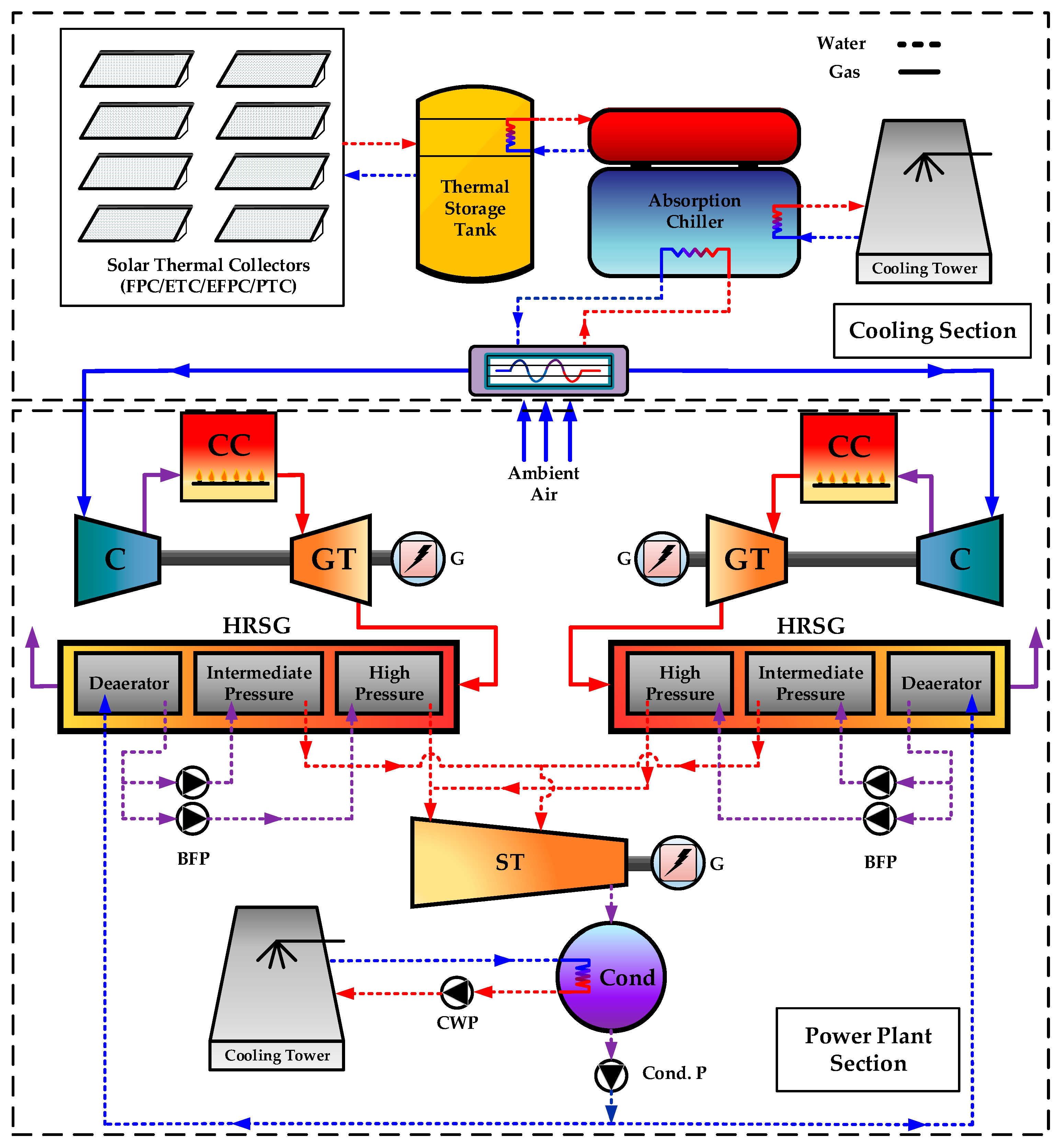
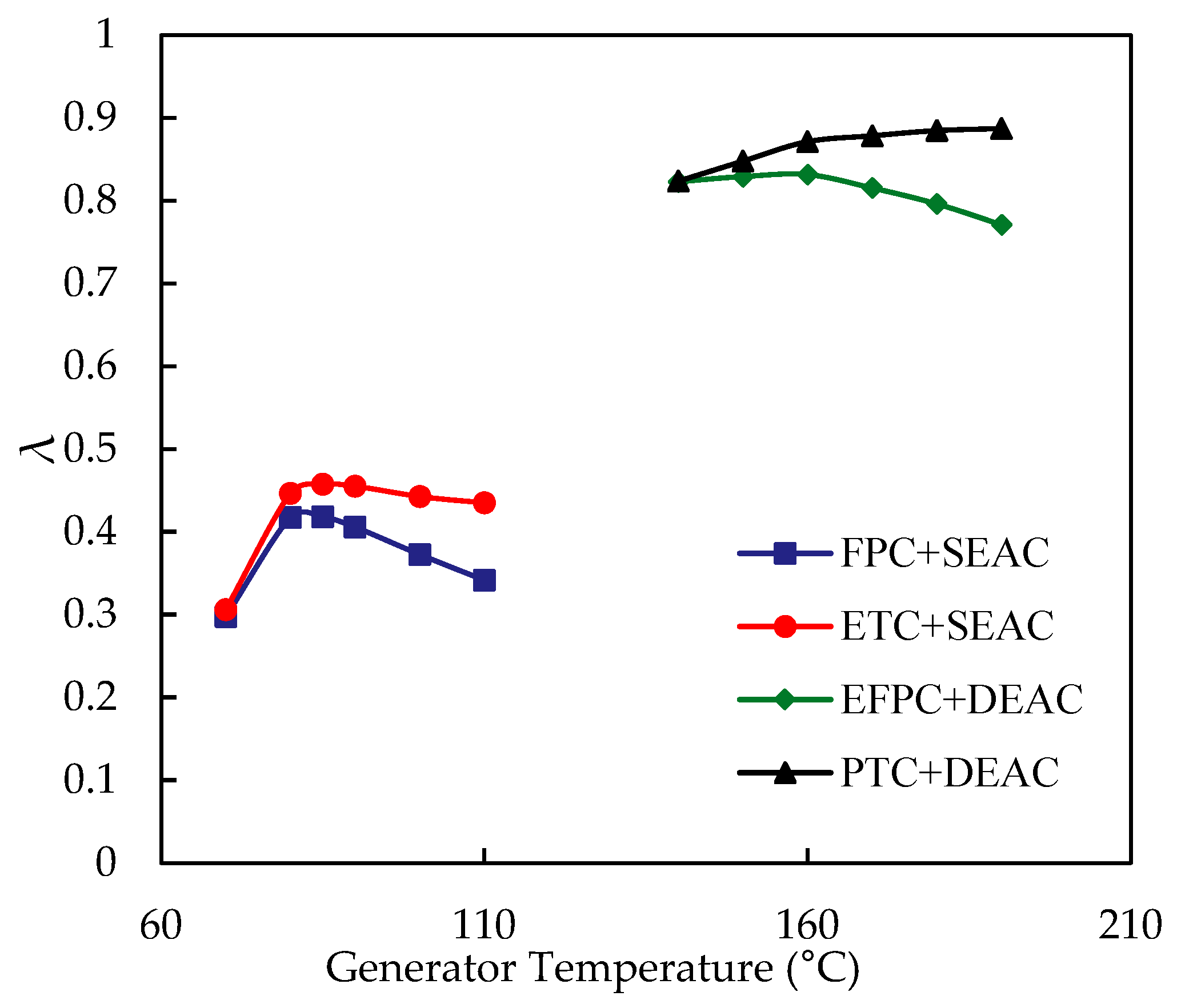
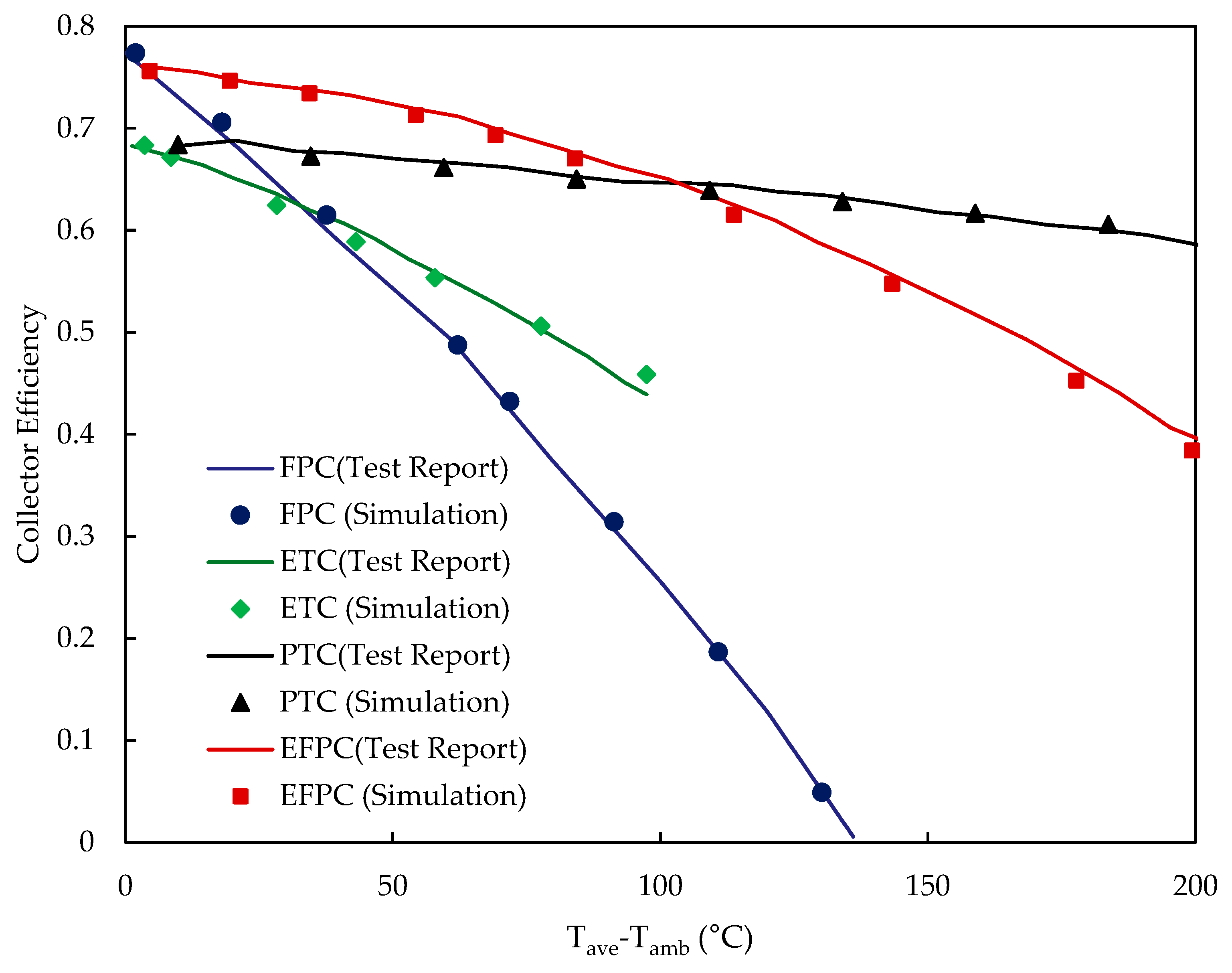

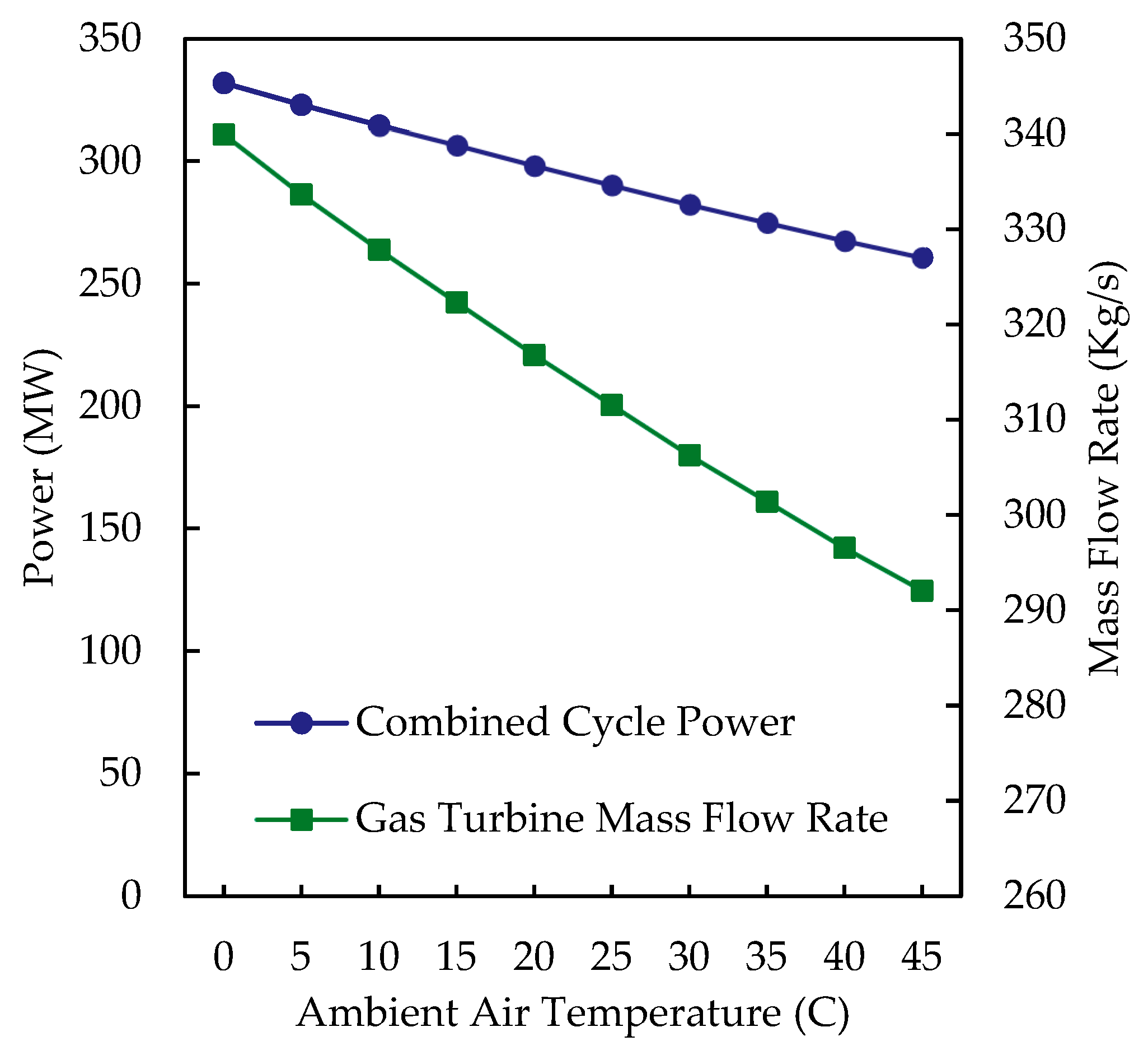

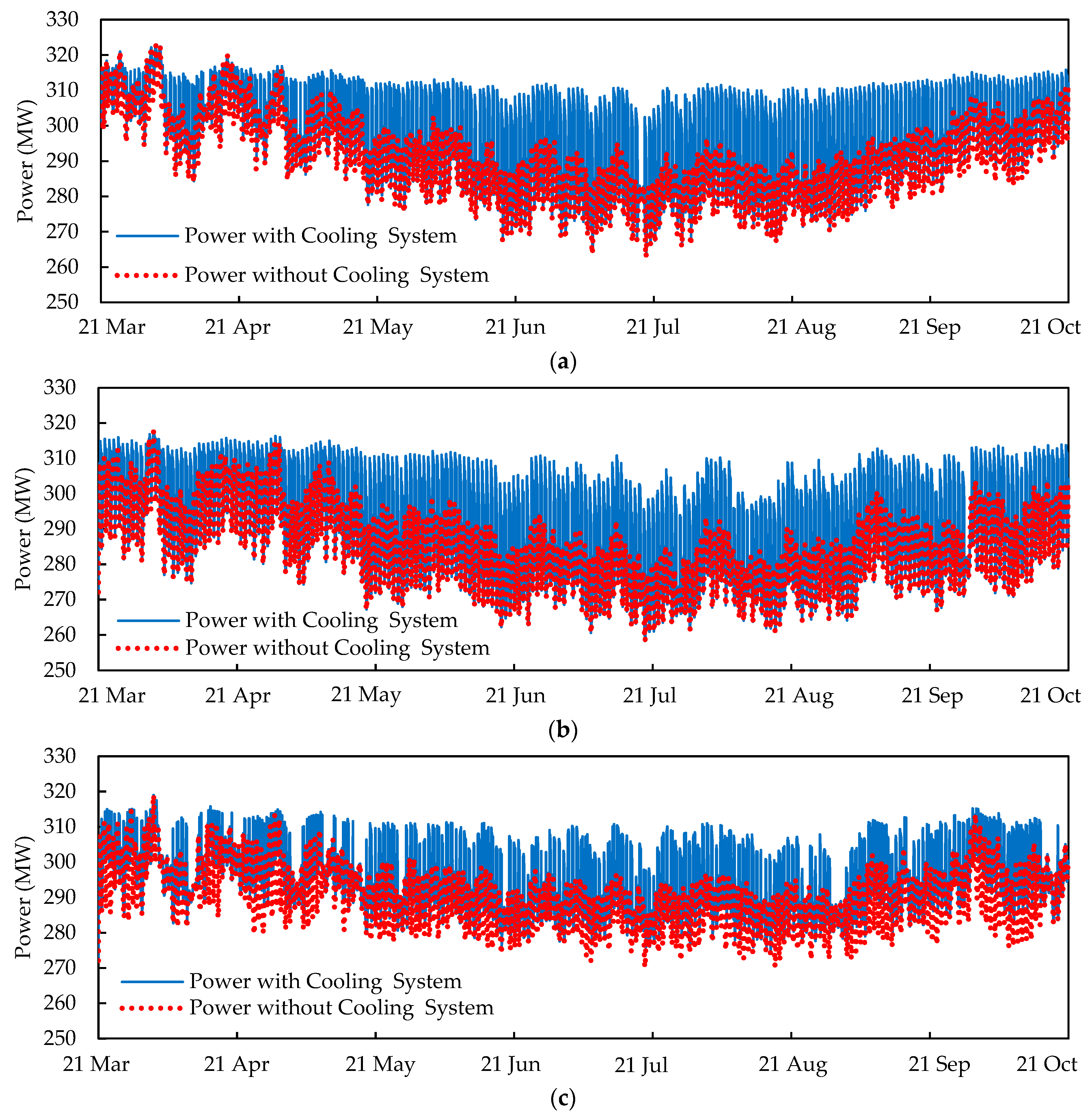


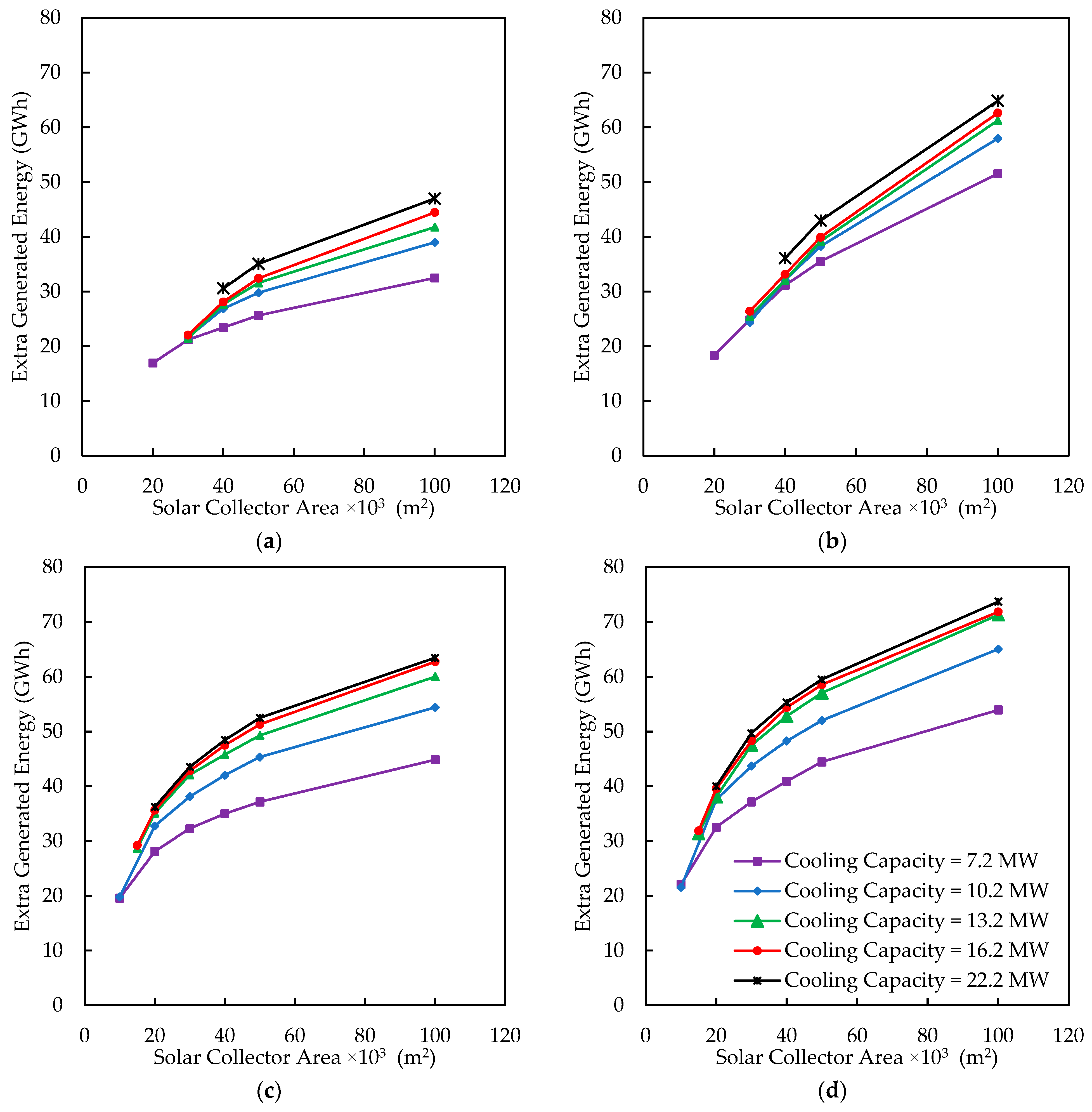
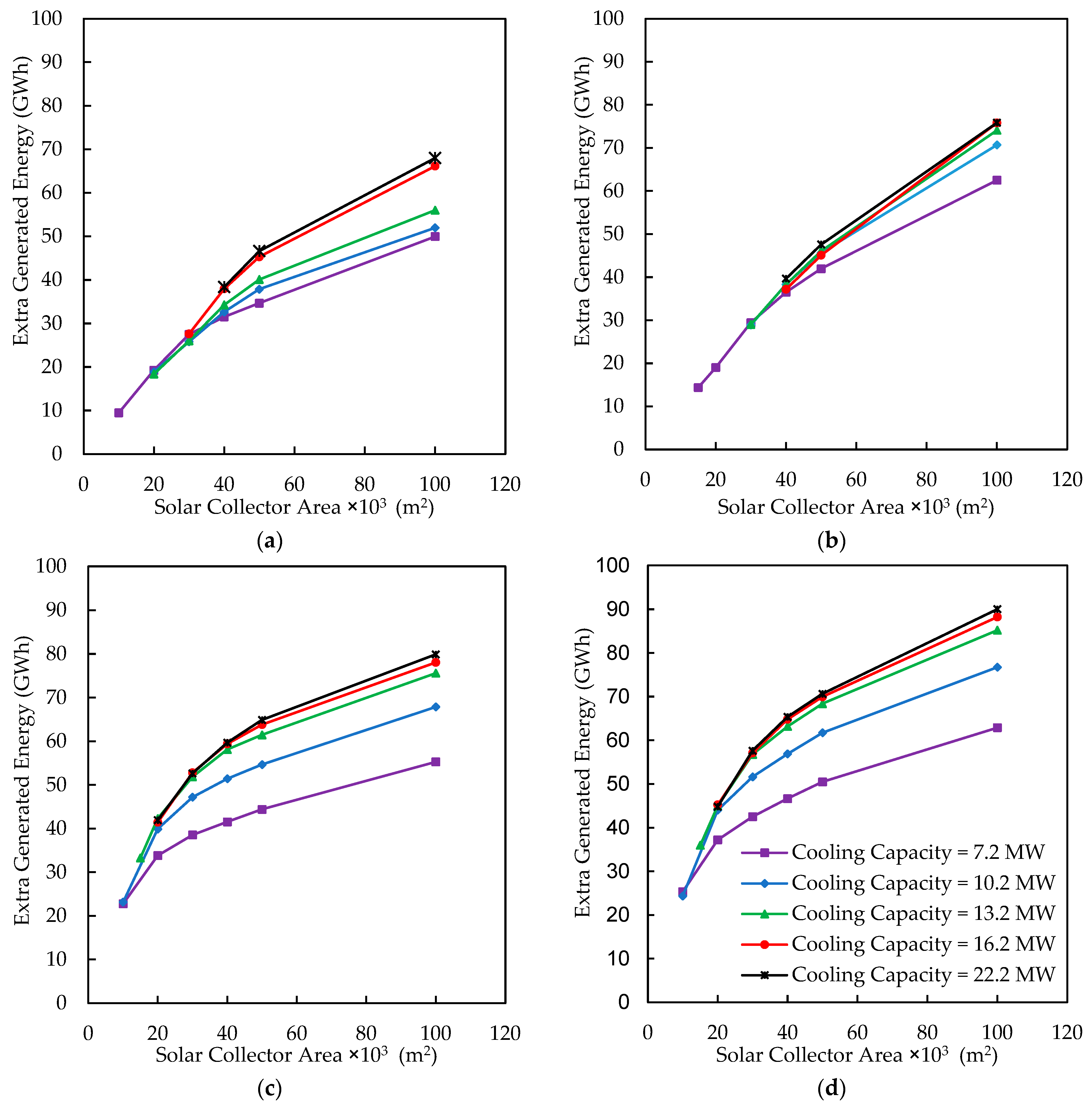

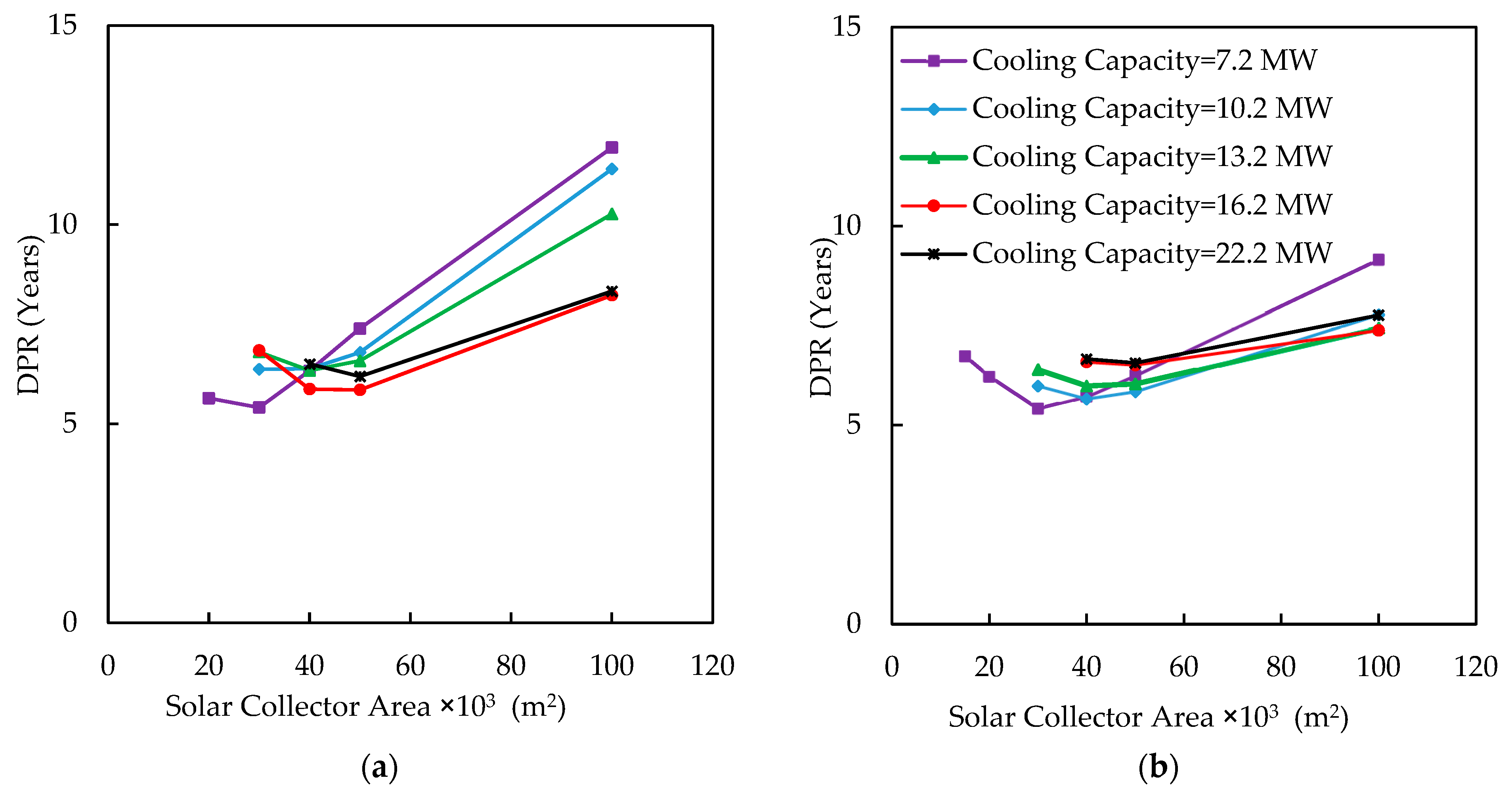

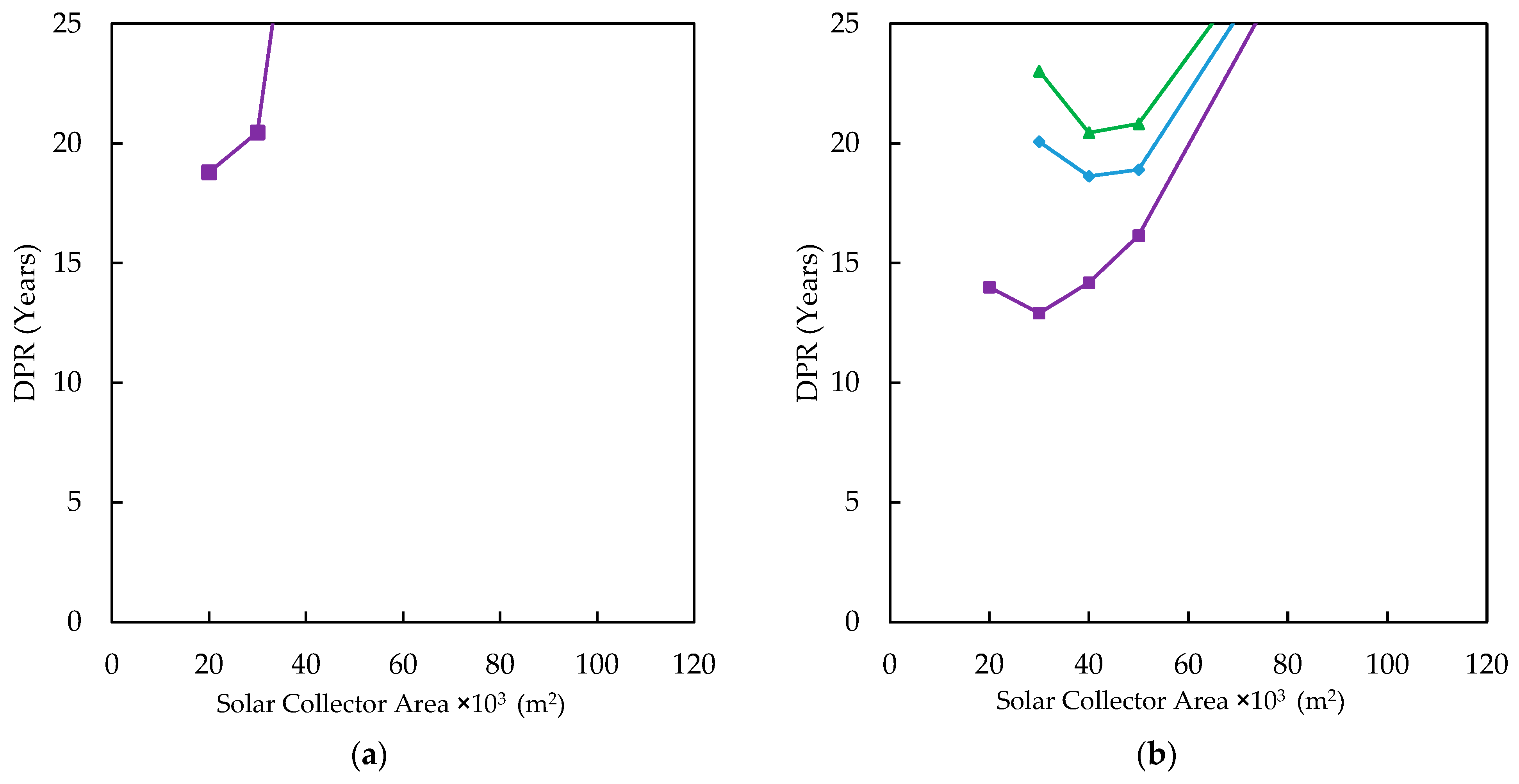

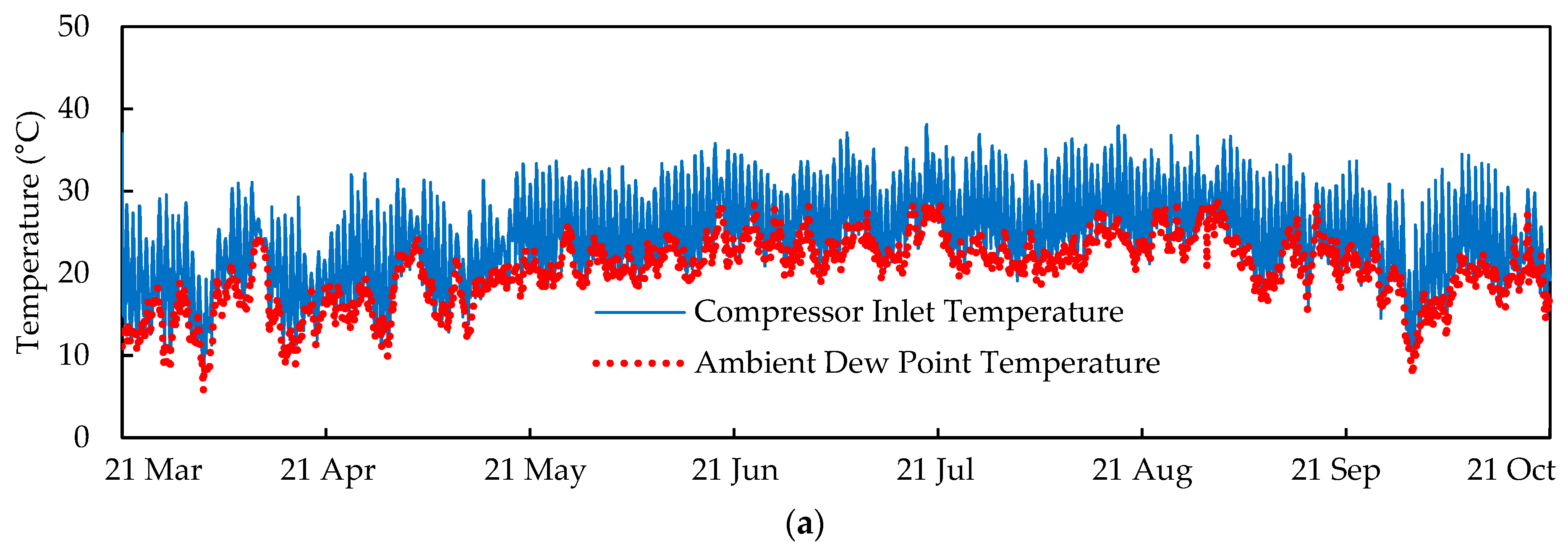

| Component/Economic Parameter | Value |
|---|---|
| FPC cost [36] | 344 ($/m2) |
| ETC cost [38] | 376 ($/m2) |
| EFPC cost [38] | 400 ($/m2) |
| PTC cost [36] | 489 ($/m2) |
| SEAC cost [40] | = −0.0049 CC2 + 188.52 CC + 125,664 ($) |
| DEAC cost [40] | = −0.0038 CC2 + 145.02 CC + 96,665 ($) |
| Thermal storage tank [42] | 650 ($/m3) |
| Cooling tower cost [42] | 55 ($/kW) |
| Pump cost [43] | |
| Installation cost [44] | 5% of total component cost |
| Discount rate [44] | 5.5% |
| Lifetime of the system | 25 years |
| Electricity price in the USA [44] | 0.12 ($/kWh) |
| Electricity price in Iran [45] | 0.04 ($/kWh) |
Disclaimer/Publisher’s Note: The statements, opinions and data contained in all publications are solely those of the individual author(s) and contributor(s) and not of MDPI and/or the editor(s). MDPI and/or the editor(s) disclaim responsibility for any injury to people or property resulting from any ideas, methods, instructions or products referred to in the content. |
© 2023 by the authors. Licensee MDPI, Basel, Switzerland. This article is an open access article distributed under the terms and conditions of the Creative Commons Attribution (CC BY) license (https://creativecommons.org/licenses/by/4.0/).
Share and Cite
Roshanzadeh, B.; Asadi, A.; Mohan, G. Technical and Economic Feasibility Analysis of Solar Inlet Air Cooling Systems for Combined Cycle Power Plants. Energies 2023, 16, 5352. https://doi.org/10.3390/en16145352
Roshanzadeh B, Asadi A, Mohan G. Technical and Economic Feasibility Analysis of Solar Inlet Air Cooling Systems for Combined Cycle Power Plants. Energies. 2023; 16(14):5352. https://doi.org/10.3390/en16145352
Chicago/Turabian StyleRoshanzadeh, Behnam, Ashkan Asadi, and Gowtham Mohan. 2023. "Technical and Economic Feasibility Analysis of Solar Inlet Air Cooling Systems for Combined Cycle Power Plants" Energies 16, no. 14: 5352. https://doi.org/10.3390/en16145352
APA StyleRoshanzadeh, B., Asadi, A., & Mohan, G. (2023). Technical and Economic Feasibility Analysis of Solar Inlet Air Cooling Systems for Combined Cycle Power Plants. Energies, 16(14), 5352. https://doi.org/10.3390/en16145352





